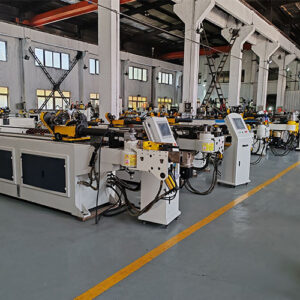Some Tips on the Maintenance and Maintenance of the Pipe Bender
Maintaining your pipe bender is crucial for ensuring its longevity, accuracy, and safe operation. This comprehensive guide delves into the essential aspects of pipe bender maintenance, offering practical tips and insights to keep your equipment in peak condition.

Understanding the Importance of Regular Maintenance
Before diving into the specifics, let’s understand why regular maintenance is paramount. A pipe bender, like any complex piece of machinery, is subjected to significant stress and wear during operation. Neglecting maintenance can lead to a cascade of problems, including:
- Premature wear and tear: Lack of lubrication and cleaning can accelerate the wear of critical components like dies, rollers, and hydraulic systems.
- Reduced accuracy and repeatability: Worn parts can compromise the bending precision, leading to inconsistent results and wasted material.
- Increased downtime and repair costs: Ignoring minor issues can escalate into major breakdowns, resulting in costly repairs and production delays.
- Safety hazards: Malfunctioning equipment can pose a serious threat to operators, potentially causing injuries.
Daily Maintenance Checklist
Daily maintenance involves simple yet crucial checks that can prevent many common problems. These checks should ideally be performed before and after each use:
- Visual Inspection: Examine the machine for any visible signs of damage, such as cracks, leaks, or loose parts. Pay particular attention to the bending dies, rollers, and hydraulic hoses.
- Lubrication: Proper lubrication is essential for reducing friction and wear. Lubricate all moving parts according to the manufacturer’s recommendations. Use the correct type and grade of lubricant to avoid damage.
- Cleaning: Remove any debris, dirt, or metal shavings from the machine. This prevents contamination and ensures accurate bending. Pay special attention to the die grooves and roller surfaces.
- Hydraulic Fluid Level: Check the hydraulic fluid level and top it off if necessary. Low fluid levels can lead to overheating and damage to the hydraulic system.
- Pressure Check: Monitor the hydraulic pressure gauge for any fluctuations or abnormalities. Consult the manufacturer’s manual for the correct pressure range.
Weekly Maintenance Tasks
In addition to daily checks, incorporate the following weekly maintenance tasks into your routine:
- Detailed Inspection: Conduct a more thorough inspection of all components, including the electrical system, control panel, and safety features.
- Die and Roller Inspection: Carefully inspect the bending dies and rollers for wear and tear. Replace any damaged or worn parts promptly.
- Hydraulic Hose Inspection: Check the hydraulic hoses for cracks, leaks, or bulges. Replace any damaged hoses immediately.
- Filter Check: Inspect and clean or replace the hydraulic fluid filter. A clogged filter can restrict fluid flow and damage the hydraulic system.
Monthly Maintenance Procedures
Monthly maintenance involves more in-depth checks and adjustments:
- Hydraulic System Flush: Consider flushing the hydraulic system and replacing the fluid every few months, or as recommended by the manufacturer. This removes contaminants and ensures optimal performance.
- Calibration Check: Verify the accuracy of the bender by performing test bends. Adjust the machine if necessary to maintain precise bending angles.
- Electrical System Check: Inspect all electrical connections, wiring, and components for damage or wear. Ensure that all safety features are functioning correctly.
Annual Maintenance and Overhaul
An annual overhaul is crucial for maintaining the long-term health of your pipe bender. This typically involves:
- Comprehensive Inspection: A thorough inspection of all components, including disassembly and cleaning of critical parts.
- Replacement of Wear Parts: Replace any worn or damaged parts, including seals, gaskets, and bearings.
- Hydraulic System Service: A complete service of the hydraulic system, including flushing, filter replacement, and pressure testing.
- Electrical System Service: Inspection and testing of all electrical components, including the control panel and safety circuits.
- Lubrication System Service: Cleaning and refilling of the lubrication system.
Choosing the Right Lubricants and Cleaning Agents
Using the correct lubricants and cleaning agents is crucial for preventing damage and ensuring optimal performance. Consult the manufacturer’s recommendations for specific product types and grades. Avoid using harsh chemicals or abrasive cleaners that can damage the machine’s surfaces.
Training and Safety
Proper training is essential for safe and efficient operation of the pipe bender. Ensure that all operators are familiar with the machine’s controls, safety features, and maintenance procedures. Emphasize the importance of following safety guidelines and wearing appropriate personal protective equipment (PPE).




